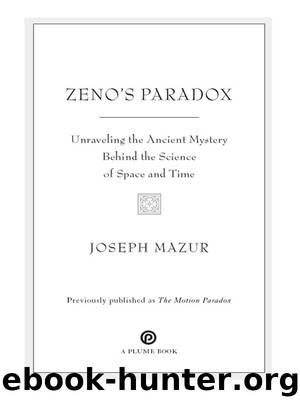Zeno's Paradox by Joseph Mazur

Author:Joseph Mazur
Language: eng
Format: epub
Publisher: Penguin Publishing Group
Published: 2007-04-14T04:00:00+00:00
THE GHOST OF Zeno appeared in 1734 as George Berkeley, the Anglican Bishop of Cloyne in County Cork, Ireland. In Berkeley’s view, calculus, the new mathematics, failed to conform to intuitive notions of continuity and had been built on weak foundations. The subtitle of his essay The Analyst gives his point of view: Or a Discourse Addressed to an Infidel Mathematician. Wherein It Is Examined Whether the Object, Principles, and Inferences of the Modern Analysis [meaning calculus] Are More Distinctly Conceived, or More Evidently Deduced, than Religious Mysteries and Points of Faith. “First Cast the Beam Out of Thine Own Eye; and Then Shalt Thou See Clearly to Cast Out the Mote Out of Thy Brother’s Eye.” The real argument was over the justification of Newton’s ambiguous meaning of limits of ratios where both numerator and denominator tend toward zero, a misleading notion that ignored all the appreciation of the subtle nuances and difficulties of infinity and continuity. To Berkeley, it seemed zero divided by zero was a meaningless contradiction.
The Bishop was right, just as Zeno was. Intuition is fine for those with good intuition: Euler, Fermat, Newton, and Leibniz. The danger was that something slyly anarchic could slip through the front gates of calculus disguised as the legitimate heir to a proven theorem. By the end of the eighteenth century, mathematical contradictions were multiplying. Yet practical applications of calculus and coordinate geometry were exploding, improving human lives and knowledge of the real world without regard to the inconsistencies sneaking through the gates of reason. Despite those inconsistencies, this math blossomed for more than two centuries, ignoring its loose footing on logic, with remarkably few serious errors.
Mathematics developed hand in hand with practical needs, developing new fields as they emerged. Questions about motion turned into abstract questions about velocity, tangents to curves, maximum values, and lengths of curves. The answers, even preliminary tentative ones, gave tremendous insight into practical problems. Fermat, Newton, and Huygens studied the angle at which a ray of light bends when passing through a lens, which requires knowing the tangent to the surface of the lens. Others applied this new math to warfare, such as the range of a cannon, which depends on the initial angle of flight of the cannonball. Euler and Lagrange set up the wave equations for the propagation of sound; Daniel Bernoulli analyzed the tones given off by musical wind instruments, while Jean-Philippe Rameau was writing for harpsichord and flute. Interest in new musical instruments prompted work on understanding the vibrating string after Bach adapted the concerto principle to keyboard and orchestra. In 1747 and 1748, Euler and d’Alembert made many contributions to the mathematical theories of music, including an understanding of the waves of a vibrating drum, while studying the motion of strings on musical instruments.
Download
This site does not store any files on its server. We only index and link to content provided by other sites. Please contact the content providers to delete copyright contents if any and email us, we'll remove relevant links or contents immediately.
The Complete Stick Figure Physics Tutorials by Allen Sarah(7307)
Secrets of Antigravity Propulsion: Tesla, UFOs, and Classified Aerospace Technology by Ph.D. Paul A. Laviolette(5309)
Thing Explainer by Randall Munroe(3877)
The River of Consciousness by Oliver Sacks(3539)
The Order of Time by Carlo Rovelli(3145)
How To by Randall Munroe(3035)
A Brief History of Time by Stephen Hawking(2960)
I Live in the Future & Here's How It Works by Nick Bilton(2935)
The Great Unknown by Marcus du Sautoy(2647)
What If?: Serious Scientific Answers to Absurd Hypothetical Questions by Randall Munroe(2637)
Midnight in Chernobyl by Adam Higginbotham(2483)
Blockchain: Ultimate Step By Step Guide To Understanding Blockchain Technology, Bitcoin Creation, and the future of Money (Novice to Expert) by Keizer Söze(2445)
Networks: An Introduction by Newman Mark(2360)
The Meaning of it All by Richard Feynman(2300)
Easy Electronics by Charles Platt(2281)
The Tao of Physics by Fritjof Capra(2229)
Midnight in Chernobyl: The Untold Story of the World's Greatest Nuclear Disaster by Adam Higginbotham(2177)
When by Daniel H Pink(2083)
Introducing Relativity by Bruce Bassett(2076)
